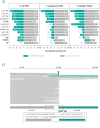Sourcing Phage-Encoded Terminators Using ONT-cappable-seq for SynBio Applications in Pseudomonas
- PMID: 37092882
- PMCID: PMC10204088
- DOI: 10.1021/acssynbio.3c00101
Sourcing Phage-Encoded Terminators Using ONT-cappable-seq for SynBio Applications in Pseudomonas
Abstract
Efficient transcriptional terminators are essential for the performance of genetic circuitry in microbial SynBio hosts. In recent years, several libraries of characterized strong terminators have become available for model organisms such as Escherichia coli. Conversely, terminator libraries for nonmodel species remain scarce, and individual terminators are often ported over from model systems, leading to unpredictable performance in their new hosts. In this work, we mined the genomes of Pseudomonas infecting phages LUZ7 and LUZ100 for transcriptional terminators utilizing the full-length RNA sequencing technique "ONT-cappable-seq" and validated these terminators in three Gram-negative hosts using a terminator trap assay. Based on these results, we present nine terminators for E. coli, Pseudomonas putida, and Pseudomonas aeruginosa, which outperform current reference terminators. Among these, terminator LUZ7 T50 displays potent bidirectional activity. These data further support that bacteriophages, as evolutionary-adapted natural predators of the targeted bacteria, provide a valuable source of microbial SynBio parts.
Conflict of interest statement
The authors declare no competing financial interest.
Figures




Similar articles
-
Obtaining Detailed Phage Transcriptomes Using ONT-Cappable-Seq.Methods Mol Biol. 2024;2793:207-235. doi: 10.1007/978-1-0716-3798-2_14. Methods Mol Biol. 2024. PMID: 38526733 Review.
-
Transcriptomics-Driven Characterization of LUZ100, a T7-like Pseudomonas Phage with Temperate Features.mSystems. 2023 Apr 27;8(2):e0118922. doi: 10.1128/msystems.01189-22. Epub 2023 Feb 16. mSystems. 2023. PMID: 36794936 Free PMC article.
-
Development of ONT-cappable-seq to unravel the transcriptional landscape of Pseudomonas phages.Comput Struct Biotechnol J. 2022 May 23;20:2624-2638. doi: 10.1016/j.csbj.2022.05.034. eCollection 2022. Comput Struct Biotechnol J. 2022. PMID: 35685363 Free PMC article.
-
Expanding the Toolbox of Broad Host-Range Transcriptional Terminators for Proteobacteria through Metagenomics.ACS Synth Biol. 2019 Apr 19;8(4):647-654. doi: 10.1021/acssynbio.8b00507. Epub 2019 Apr 9. ACS Synth Biol. 2019. PMID: 30943009
-
Exploring the synthetic biology potential of bacteriophages for engineering non-model bacteria.Nat Commun. 2020 Oct 20;11(1):5294. doi: 10.1038/s41467-020-19124-x. Nat Commun. 2020. PMID: 33082347 Free PMC article. Review.
Cited by
-
Exploring the transcriptional landscape of phage-host interactions using novel high-throughput approaches.Curr Opin Microbiol. 2024 Feb;77:102419. doi: 10.1016/j.mib.2023.102419. Epub 2024 Jan 24. Curr Opin Microbiol. 2024. PMID: 38271748 Free PMC article. Review.
-
Meeting Report of the Second Symposium of the Belgian Society for Viruses of Microbes and Launch of the Phage Valley.Viruses. 2024 Feb 15;16(2):299. doi: 10.3390/v16020299. Viruses. 2024. PMID: 38400074 Free PMC article.
-
Obtaining Detailed Phage Transcriptomes Using ONT-Cappable-Seq.Methods Mol Biol. 2024;2793:207-235. doi: 10.1007/978-1-0716-3798-2_14. Methods Mol Biol. 2024. PMID: 38526733 Review.
-
Engineering a phi15-based expression system for stringent gene expression in Pseudomonas putida.Commun Biol. 2025 Feb 4;8(1):171. doi: 10.1038/s42003-025-07508-y. Commun Biol. 2025. PMID: 39905116 Free PMC article.
-
Assessing the transcriptional landscape of Pseudomonas phage 201ϕ2-1: Uncovering the small regulatory details of a giant phage.Microb Biotechnol. 2024 Oct;17(10):e70037. doi: 10.1111/1751-7915.70037. Microb Biotechnol. 2024. PMID: 39460739 Free PMC article.
References
Publication types
MeSH terms
LinkOut - more resources
Full Text Sources
Molecular Biology Databases

